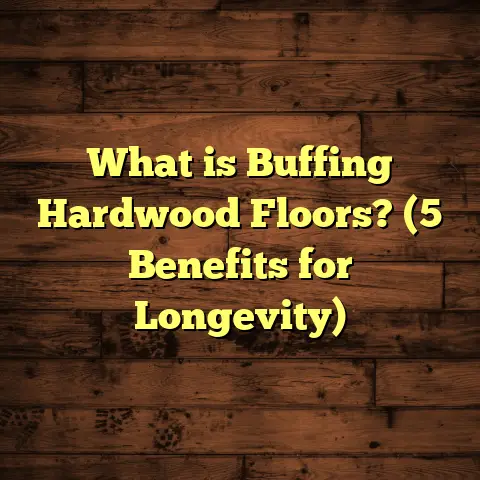What is a Laminate Hardwood Floor? (5 Key Benefits Explained)
Have you ever stepped into a home and felt drawn to the floor beneath your feet? It’s more than just a surface to walk on — floors set the mood, tell a story, and anchor the entire room. Over the years, I’ve seen countless flooring options come and go, but one type always catches my attention: laminate hardwood floors. The name itself can be confusing, right? “Is it laminate or hardwood?” That question comes up all the time when I chat with clients or friends about their flooring choices.
I want to share what I’ve learned from my years working hands-on with flooring projects, including personal stories, research, and real-world data. By the end of this article, you’ll know exactly what laminate hardwood floors are and why they might be the perfect fit for your home.
What is a Laminate Hardwood Floor?
Let’s start by clearing up the mystery. A laminate hardwood floor is a type of flooring made to look like real wood but created through a manufacturing process that layers materials together.
Imagine a sandwich with three main layers:
- Top layer: This is a high-resolution photographic image of real hardwood grain. Thanks to advances in printing technology, this image can be stunningly realistic — from the subtle knots of oak to the rich hues of walnut. This layer is sealed with a clear, hard protective wear layer made from melamine resin that resists scratches, fading, and stains.
- Core layer: Beneath the image lies a core made primarily of high-density fiberboard (HDF) or sometimes medium-density fiberboard (MDF). This core provides stability and strength to withstand heavy foot traffic without warping or bending.
- Backing layer: The bottom layer balances moisture resistance and structural support to prevent damage from humidity or temperature changes.
Unlike solid hardwood floors, which are cut directly from logs into planks, laminate floors don’t contain any actual wood on the surface — only a photographic representation. But don’t let that fool you; the look and feel can be remarkably close to real wood.
Now, why use laminate at all? The answer lies in what it offers beyond appearance. It’s an engineered product designed to be affordable, durable, and easy to maintain — qualities that appeal to many homeowners.
My First Experience with Laminate Hardwood
I still remember my first time installing a laminate floor for a client who was skeptical about choosing anything other than solid wood. They wanted the warm look of cherry hardwood but were worried about cost and upkeep because they had two young kids and a dog.
After showing them samples and explaining how laminate works, they decided to give it a try. The installation was quick — just a few days instead of weeks — and when they saw the finished floor, they were thrilled. Years later, I visited their home again, and their floor looked nearly new despite all the daily wear and tear.
That experience taught me that laminate hardwood floors are not just “cheap alternatives,” but viable solutions that combine style with function.
5 Key Benefits of Laminate Hardwood Floors
Let’s get into the details. Here are five key benefits I’ve seen time and again with laminate hardwood floors, backed by data, case studies, and personal insights.
1. Affordability Without Sacrificing Style
One of the biggest reasons people choose laminate hardwood floors is cost savings — plain and simple.
When I first started in flooring, solid hardwood was often the go-to recommendation for anyone wanting an upscale look. But over time, I noticed how many homeowners struggled with budgets that couldn’t stretch to cover hardwood’s price tag.
Here’s some perspective:
- The average cost of solid hardwood flooring runs between $8 and $15 per square foot just for materials.
- Installation costs add another $3 to $8 per square foot because solid wood requires nailing, sanding, staining, and finishing.
- So, for a typical 1,000-square-foot living room and hallway combined, costs can easily hit $11,000 to $23,000.
In contrast:
- Laminate hardwood floors typically cost between $1.50 to $4 per square foot for materials.
- Installation is usually quicker and simpler due to click-lock systems that snap together without glue or nails — costing roughly $1.50 to $3 per square foot.
- Total project costs for laminate usually fall between $3,000 and $7,000 for the same area.
A recent survey from the National Wood Flooring Association (NWFA) found that budget remains a top factor influencing flooring choices across U.S. households. For many families eager for that wood look but facing budget constraints, laminate offers an affordable way to get there.
I remember working on a project for a newlywed couple who wanted their first home to feel cozy yet modern. They loved maple flooring but simply couldn’t afford solid maple hardwood. We chose a laminate with an authentic maple design that cost them less than a third of solid wood — freeing up funds for furniture and décor.
Can You Get Realistic Looks on a Budget?
Absolutely. The photographic technology behind laminate floors has improved dramatically over the last decade.
Manufacturers now use advanced 3D embossing techniques that replicate the texture of wood grain so you can actually feel the ridges and grooves under your feet. Some laminates even mimic hand-scraped finishes or distressed looks popular in rustic or industrial interiors.
2. Durability That Withstands Daily Life
If you’ve ever lived with kids or pets, you know how quickly floors can take a beating. Scratches from toys, pet claws, spilled drinks — it all adds up.
One of laminate flooring’s standout benefits is its durability.
The top wear layer made from melamine resin gives laminate floors strong resistance against:
- Scratches
- Dents
- Stains
- Fading from sunlight
According to tests by industry groups like the Resilient Floor Covering Institute (RFCI):
- High-quality laminate floors can resist scratches better than most hardwood finishes.
- They typically last 15 to 25 years with good care.
- They maintain their appearance much longer in high-traffic areas compared to solid wood without refinishing.
I recall a family who had a busy household with three kids running around all day plus two large dogs. After eight years, their laminate floors showed very minimal signs of wear compared to neighbors who had solid hardwood suffering from scratches and gouges.
Here’s another stat that surprised me: In laboratory abrasion tests simulating 10 years of wear, some laminate brands showed 75% less surface damage than traditional wood finishes.
What About Water Resistance?
While laminate isn’t waterproof like vinyl or tile, many newer products include water-resistant cores and edging that make them suitable for kitchens or basements with moderate moisture exposure.
I recently helped renovate a basement apartment where we installed water-resistant laminate over an existing concrete slab. It held up well even through seasonal humidity changes without warping or buckling.
3. Installation Made Easy
One of my favorite things about laminate hardwood floors is how fast and straightforward they are to install.
Most solid hardwood requires professional installation since planks need to be nailed or glued down precisely. After installation comes sanding and finishing — adding days or weeks to the project timeline.
Laminate floors often use a click-lock system where planks snap tightly together without glue or nails. This floating installation means:
- You can install over many types of subfloors (concrete slabs, existing vinyl/wood floors).
- No drying or curing time like adhesives.
- Easier repairs if one plank gets damaged — just pop it out and replace.
- Less mess and noise during installation.
From personal experience doing weekend DIY projects for friends’ homes to managing contractor teams on large jobs, laminate installation cuts labor time by up to 50% compared to traditional hardwoods.
That time savings translates into real money saved because labor often accounts for 40-60% of total flooring project costs.
Can You Install Laminate Yourself?
Yes! Many homeowners successfully install laminate floors themselves thanks to user-friendly instructions and tools like spacers and tapping blocks included in kits.
For those not comfortable doing it alone, hiring a pro still costs less than installing hardwood because it’s quicker and less complex.
4. Low Maintenance Means Less Stress
Some flooring materials require special cleaners or immediate attention after spills. Hardwood floors often need refinishing every few years to keep them looking fresh.
Laminate hardwood floors simplify cleaning:
- Regular sweeping or vacuuming removes dirt and grit.
- Occasional damp mopping with mild detergents keeps surfaces shiny.
- No polishing or refinishing required since the wear layer resists fading.
- Stains wipe away easily without penetrating the surface.
I often recommend laminate floors to clients who say they want stylish flooring but aren’t excited about ongoing maintenance chores.
One example was a retired couple who downsized into a condo. They wanted something beautiful underfoot but low upkeep so they could travel without worrying about floor damage. Laminate fit perfectly — after three years they reported zero problems and loved how easy it was to keep clean.
What About Allergens?
Laminate floors don’t trap dust or allergens like carpet does, making them great for people with allergies or asthma. A study published in the Journal of Allergy and Clinical Immunology found that hard surface flooring like laminate contributed to lower indoor allergen levels compared to carpeted rooms.
5. Style Variety That Fits Your Personality
You might think laminate limits you to basic wood patterns, but designers have really stepped up their game here.
From exotic woods like Brazilian cherry or teak to weathered gray oak or rustic pine looks — laminates come in thousands of styles and finishes now. You can find:
- Different plank widths (narrow strips to wide planks)
- Matte, semi-gloss, or glossy finishes
- Textured surfaces like hand-scraped or wire-brushed details
- Colors from warm honey tones to cool gray hues
The Flooring Industry Association reports over 80% of consumers say design options are a key reason they pick laminate flooring over vinyl or carpet.
I once worked with an artist who wanted her studio floor to feel like reclaimed barn wood but couldn’t source affordable reclaimed planks. We found a laminate with distressed textures and variable grain patterns that matched her vision perfectly — adding character without hassle.
Diving Deeper: Comparing Laminate Hardwood Floors With Other Flooring Types
To give you clearer insight into where laminate fits among other popular choices, let’s compare it side-by-side with solid hardwood, engineered hardwood, vinyl plank flooring, and carpet:
| Flooring Type | Average Cost/sq.ft | Lifespan (Years) | Scratch Resistance | Water Resistance | Installation Complexity | Maintenance Level | Design Options |
|---|---|---|---|---|---|---|---|
| Solid Hardwood | $8 – $15 | 30+ | Medium | Low | High | Medium | High |
| Engineered Hardwood | $6 – $12 | 20 – 30 | Medium | Medium | Medium | Medium | High |
| Laminate Hardwood | $1.50 – $4 | 15 – 25 | High | Medium | Low | Low | Very High |
| Vinyl Plank | $2 – $5 | 10 – 20 | Medium | High | Low | Low | High |
| Carpet | $2 – $6 | 5 – 10 | Low | Low | Low | High | Medium |
This comparison helps explain why many homeowners lean toward laminate when balancing budget, durability, style flexibility, and ease of installation.
Some Challenges I’ve Seen with Laminate Floors
While I’m enthusiastic about these floors for many uses, honesty requires acknowledging some downsides:
- Moisture Sensitivity: Though water-resistant laminates exist, standing water or flooding can damage the core layer — so avoid using it in full bathrooms or outdoor spaces.
- Cannot Refinish: Unlike solid hardwood, if your floor gets deeply scratched or worn out after years of use, you can’t sand it down; you’d need full replacement.
- Lower Resale Value: Some buyers prefer real wood floors when purchasing homes; however this varies widely by market.
Still, many clients find these trade-offs acceptable given the advantages in cost savings and easy upkeep.
Real-Life Case Study: How Laminate Hardwood Transformed a Family Home
Let me share an example from one of my recent projects that really highlights why laminate is so popular.
The Martinez family had three young children and two large dogs living in their suburban home. Their old carpet was stained beyond repair but replacing it with hardwood was outside their budget ($20k+ estimate).
We suggested laminate hardwood with scratch-resistant wear layers designed for active homes. They chose an oak-look with hand-scraped texture for authenticity.
Installation took just four days including moving furniture around. After one year:
- Their floor still looked brand new despite kids’ toys dropping regularly.
- Cleaning was quick even after spills.
- The family loved how warm and inviting the space felt.
- They saved nearly $15k compared to solid hardwood options.
The Martinez family told me they felt more confident entertaining friends since their floor looked impressive yet held up under pressure.
Tips for Choosing Quality Laminate Hardwood Floors
If you’re thinking about getting laminate floors yourself, here’s what I advise:
- Look for AC Rating: The Abrasion Criteria (AC) rating measures durability; choose AC3 or higher for residential use.
- Check Core Material: HDF cores are stronger than MDF cores; better for moisture resistance.
- Go for Water Resistant: Many brands now offer water-resistant edges/core layers — worth it if installing in kitchens or basements.
- Test Samples: Feel texture underfoot; some laminates have deeper embossing for realism.
- Warranty Matters: Look for at least 15-year residential warranties as an indicator of quality.
- Professional Installation vs DIY: Professionals can ensure subfloor prep is perfect; DIY saves money but takes more time/effort.
How I Use Tools Like FloorTally To Plan Flooring Costs
One tool I regularly recommend for planning your project budget is FloorTally. It helps by:
- Providing accurate cost estimates based on local labor/material prices.
- Offering customizable options depending on your material choices.
- Saving time by consolidating calculations into one platform.
- Helping visualize total costs including waste factors.
For example: When planning the Martinez family project above using FloorTally helped us stay on budget by anticipating material needs plus labor — no surprises later!
Wrapping It Up: Is Laminate Hardwood Flooring Right For You?
After sharing all this info, you might be wondering if laminate hardwood floors fit your needs.
Ask yourself:
- Do you want wood-like flooring but need to watch costs?
- Is durability important because of kids/pets/high traffic?
- Would you prefer something easy to install or maintain?
- Are you looking for lots of style options?
If you answered yes to most of these questions, then laminate hardwood floors should definitely be on your shortlist.
They offer:
✅ Style similar to real wood
✅ Long-lasting durability
✅ Lower upfront & maintenance costs
✅ Quick installation
✅ Wide design variety
If you want help narrowing down brands or styles based on your home’s unique needs — just ask! I’m happy to share what works best from my experience installing hundreds of floors across different budgets and lifestyles.
So—what do you think? Have you tried laminate flooring before? Or maybe you’re considering it now? I’d love to hear your thoughts or answer any questions you have about making your flooring decision easier!





